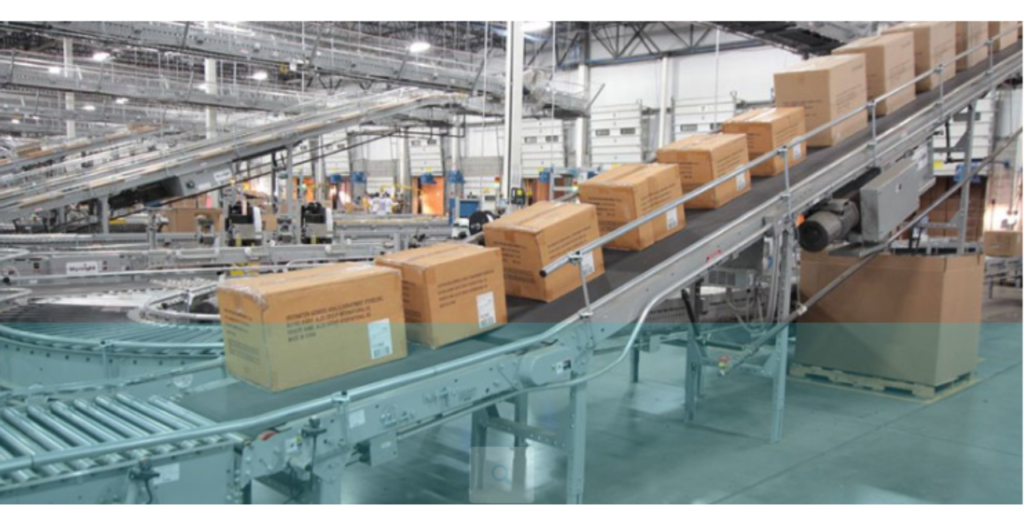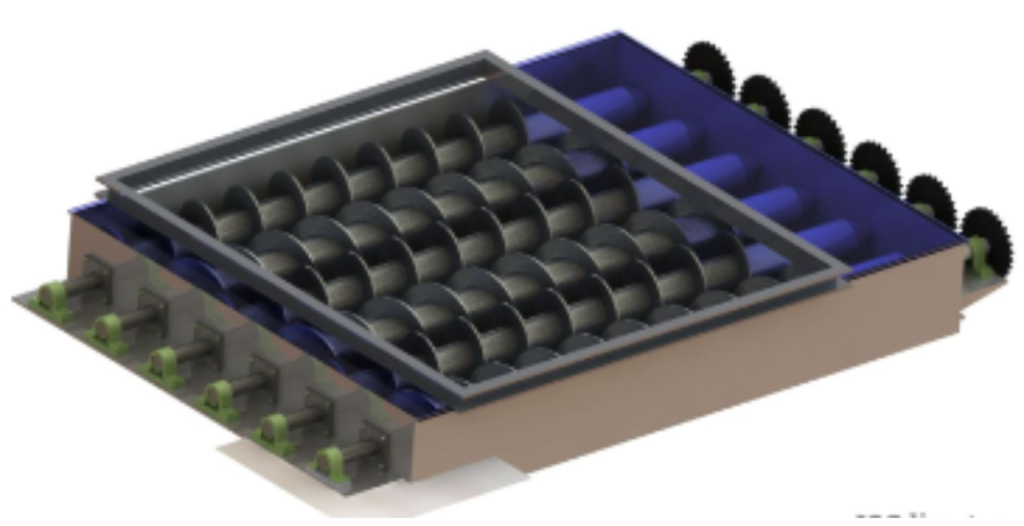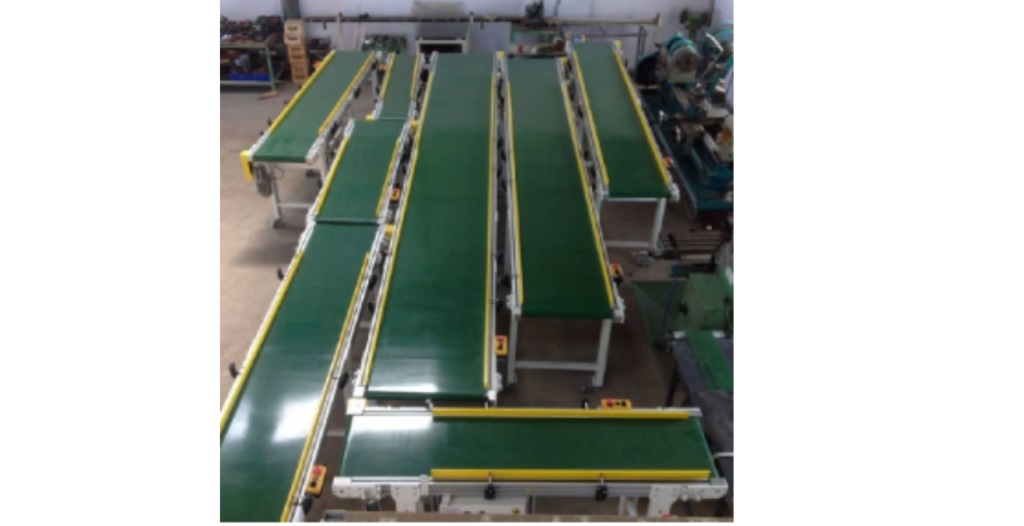CONVEYORS
Conveyors come in various types, each designed for specific applications and material-handling needs. Here are some common types of conveyors: |
| Belt Conveyors: Belt conveyors use a continuous belt made of various materials to transport bulk materials horizontally or at an incline. They are versatile and suitable for a wide range of applications, including manufacturing, mining, and distribution. |
| Roller Conveyors: Roller conveyors use a series of rollers to move materials. They are often used for pallet and carton handling in warehouses and distribution centers. |
| Screw Conveyors: Screw conveyors consist of a rotating helical screw enclosed in a tube or trough. They are used to convey bulk materials horizontally or at a slight incline and are suitable for materials that flow easily. |
| Bucket Conveyors: Bucket conveyors use buckets or cups attached to a belt, chain, or cable to transport bulk materials vertically or at an incline. They are commonly used in industries like agriculture and mining. |
| Chain Conveyors: Chain conveyors use a continuous chain to move materials. They are suitable for heavy-duty applications and can transport materials horizontally, vertically, or at an incline. |
| Pneumatic Conveyors: Pneumatic conveyors use air pressure to transport materials through a pipeline system. They are often used for materials that are fine, granular, or dusty. |
| Slat Conveyors: Slat conveyors use slats or plates to move materials. They are often used in manufacturing and assembly processes, such as in automotive production lines. |
| Drag Chain Conveyors: Drag chain conveyors use a chain with attached paddles or disks to move materials. They are suitable for moving bulk materials in a horizontal or slightly inclined path. |
| Vibrating Conveyors: Vibrating conveyors use vibrations to move materials along a trough. They are used for conveying fragile or sensitive materials and for applications like food processing. |
| Flexible Screw Conveyors: These conveyors use a flexible spiral screw enclosed in a flexible tube to convey materials. They are highly customizable and are often used in applications requiring flexibility in routing. |
| Troughed Belt Conveyors: Troughed belt conveyors have a troughed or “V” shaped belt to contain and transport bulk materials. They are suitable for conveying materials over long distances and at various inclinations. |
| Overhead Conveyors: Overhead conveyors are used for transporting materials above ground level. They are commonly used in automotive painting lines and garment handling. |
| Gravity Conveyors: Gravity conveyors use the force of gravity to move materials. They are typically used for manual or semi-automated material handling and often have a slight incline. |
| Beltless Magnetic Conveyors: These conveyors use magnets to move materials without a traditional belt. They are used in applications where cleanliness and sanitation are crucial, such as in the food industry. |
| Spiral Conveyors: Spiral conveyors use a continuous spiral path to transport materials vertically or in a circular motion. They are space-efficient and are often used in material elevation applications. |
| Trolley Conveyors: Trolley conveyors use trolleys mounted on an overhead track to transport materials. They are commonly used in assembly lines and garment handling. |
| Each type of conveyor has its own advantages and limitations, and the choice depends on the specific needs of the application and the characteristics of the materials being handled. Proper conveyor selection is crucial for efficient and safe material transport. |




Capacity & Design as per customer requirement:
Designing a conveyor system and determining its capacity involves several key considerations to ensure it meets the intended purpose and handles the required load efficiently. Here’s a step-by-step guide to designing a conveyor system and calculating its capacity:
1. Define the Conveyor’s Purpose:
- Start by clearly defining the purpose of the conveyor system. Determine what materials or products the conveyor will transport, the flow rate required, the distance it needs to cover, and any specific operational requirements.
2. Select Conveyor Type:
- Choose the most suitable type of conveyor for your application. Common conveyor types include belt conveyors, roller conveyors, screw conveyors, and bucket elevators. The choice depends on factors such as the material being transported, the environment, and the required speed and capacity.
3. Calculate Material Flow Rate:
- Determine the desired material flow rate in units such as tons per hour, kilograms per minute, or cubic meters per hour. This calculation depends on your production or transportation needs.
4. Calculate Conveyor Speed:
- Conveyor speed is crucial for meeting the desired material flow rate. Use the formula:
Conveyor Speed (m/s) = Material Flow Rate (units/hour) / Conveyor Capacity (units/hour)
5. Determine Conveyor Capacity:
- Conveyor capacity is a critical factor in design. It depends on factors such as the conveyor type, belt width, angle of inclination (if applicable), and the material’s characteristics. You may need to consult conveyor design manuals or use conveyor design software to calculate capacity accurately.
6. Calculate Conveyor Length:
- Determine the total length of the conveyor required to cover the distance between the starting and ending points. Consider any inclines, declines, or curves in the conveyor path.
7. Conveyor Belt Selection:
- If you’re using a belt conveyor, select the appropriate type of conveyor belt based on factors like material characteristics (abrasive, corrosive, etc.) and the operating environment (temperature, humidity, etc.).
8. Conveyor Frame and Support Structure:
- Design a robust frame and support structure to ensure the conveyor can handle the weight of the material and the equipment. Ensure proper alignment and adequate support throughout the conveyor’s length.
9. Drive System and Motor Selection:
- Choose the appropriate drive system (e.g., electric motor, hydraulic drive) and motor size based on the conveyor’s load and speed requirements.
10. Safety and Maintenance Considerations:
- Incorporate safety features, such as emergency stop buttons, guards, and safety interlocks. Plan for regular maintenance to keep the conveyor running smoothly.
11. Testing and Optimization:
- Before putting the conveyor into full operation, conduct tests to ensure it meets the specified capacity and performance requirements. Make any necessary adjustments or optimizations based on the results.
12. Compliance with Regulations:
- Ensure that your conveyor system complies with relevant safety and environmental regulations and standards.
Remember that conveyor design can become quite complex, especially for large-scale or specialized systems.
It’s often helpful to consult with conveyor design experts or engineers with experience in the specific type of conveyor system you need for your application. Additionally, using conveyor design software can simplify the process and provide accurate calculations.


 Sales & Marketing:
Sales & Marketing:  Service Supports:
Service Supports:  Website:
Website: 